The History Of Suzuki Swift

The Suzuki Swift is nameplate marketed by Suzuki carried by vehicles of three distinct derivations:
- Generations I, II, III: a supermini that began as an export nameplate of the Japanese domestic market Suzuki Cultus. See: Suzuki Cultus
- Generation IV: the current JDM, Europe and Oceana generation, a significant departure from the previous models, marketed solely under the nameplate "Swift". (this article)
- Canadian Swift+: the current Canada-only generation marketed under the Swift+ nameplate — a sibling of the Daewoo Kalos family. See: Daewoo Kalos
The Swift began as a marketing and manufacturing rebadge of the Suzuki Cultus, a supermini (or subcompact) manufactured and marketed worldwide across three generations and four body configurations — 3-door hatchback, 4-door sedan, 5-door hatchback and 2-door convertible — and using the Suzuki G engine family. The car was marketed in the JDM (Japanese domestic market) as the Cultus and elsewhere as the Suzuki Forsa, Chevrolet Sprint and Sprint Metro, Geo and Chevrolet Metro, Pontiac Firefly, Maruti 1000, Holden Barina, Subaru Justy, Suzuki Jazz, and Suzuki Swift. Versions of the Generation II Cultus were also produced until 2007 in India — and remain in production today in Pakistan.
The Generation IV Swift debuted at the Paris Auto Salon in September 2004 to compete in the European B segment with the Peugeot 206, Opel Corsa and the Fiat Punto. This generation of the Swift marked a significant departure with the previous Cultus-based models, with Suzuki re-designing the vehicle as less of a "low price alternative" subcompact and more of a "sporty" subcompact. The Swift's design and driving characteristics focused on the European market with its chassis refined through a road-testing program across Europe.
Available with 1.3 (92 bhp) and 1.5 (102 bhp)litre petrol engines, the new Swift is Suzuki's new "global car", to be produced in Hungary, India, Japan and by Chang'an in China.
In Japan, 3- and 5-door bodies are available and four-wheel drive is an option for the 1.3L or 1.5L petrol engine. 1.2L CVT transmission version also available in only front wheel drive version.
The design of the new Swift was previewed on the Concept S and Concept S2 concept cars at auto shows, in the years leading up to its launch.
The British Autocar magazine gave the new Swift a favourable 4/ 5 stars in road test, judging it a "thoroughly impressive all-rounder". The Generation IV Swift has received a four stars out of five rating in the EuroNCAP crash tests.
Since its global launch in 2005, which was kicked off with a marketing campaign fronted by the footballer Cristiano Ronaldo in many European countries, the Swift has recorded above forecast sales in most markets[citation needed]. In Japan, sales figures have been twice the forecast and in many European markets the model has been a runaway success[citation needed]. In Denmark, the GenIV Swift has been consistently in Top 3 for more than 2 years and was the car with the highest sales figures in 2006[citation needed]. In India, rapid sales of the new Swift model contributed to the 64% rise in Q1 profits for Maruti Suzuki. The Swift will be reintroduced to the U.S. market in 2010 to replace the Suzuki Reno.
In 2005, Swift was launched in the UK with a 1.3 litre 4-cylinder diesel engine outsourced from Fiat. The award-winning Fiat Multijet engines (known as the JTD and produced in Poland) found its way from Fiat to Suzuki because of their partnership building the Suzuki SX4. The engine is being marketed as the International Engine of the Year by Maruti-Suzuki and is based on common rail multi-jet technology from Fiat. The engine generates 75 bhp (55 kW). In 2007, Swift DDIS was launched in India.
Swift Dzire
Suzuki introduced a sedan based version of the Swift called the Maruti Swift Dzire in the Indian market. The sedan has the exact same wheelbase as the hatchback version and has an increased overall length due to the addition of the boot.
Swift Sport
In October 2005, Suzuki launched the 'Sport' version of the new Swift in Japan and in September 2006 the model was introduced in most European markets. Named "Swift Sport", it is powered by a high-revving 1.6 litre, naturally-aspirated DOHC VVT 4-cylinder engine with a 11.1:1 compression ratio, 4-2-1 exhaust manifold, High lift cams, Forged pistons, and strengthened valve springs.
The 1.6 liter engine produces 125 bhp (91 kW) at 6800 rpm and 148N·m (109lb·ft) torque at 4800 rpm.
The Swift Sport features sportier bumpers and spoilers, a stiffer suspension, twin exhaust pipes, red sport seats (with Recaro seats optional) and 4-wheel disc brakes on 16 in (40 cm) rims. The European Swift Sport features a manual only, 3-door version with 17 in (43 cm) rims and ESP.
Main article: Daewoo KalosFor the Canadian market the Swift+ was created with a joint between GM Daewoo and Suzuki, After Suzuki stopped selling the Swift (Generation III) in 2001, to be superseded by a version of the Daewoo Kalos in fall 2003 (progenitor of the Chevrolet Aveo et al), named the Suzuki Swift+ (note the 'plus' symbol) and marketed solely as a 5-door hatchback.
For the 2009 model year, the Suzuki Swift+ will be another rebaged Daewoo (Gentra). It will have an updated styling and a new Opel ECOTEC 106 hp 1.6 engine reciving 7.9 L/ 100 Km for city and 5.7 for highway from the previous 8.9/ 5.9. shared with the Pontiac G3 Wave and Chevrolet Aveo. The starting price of the 2009 Suzuki Swift+ has increase to $14,495 from its former $13,995 price.
From Wikipedia, the free encyclopedia
More About Suzuki Swift
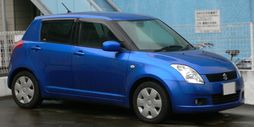
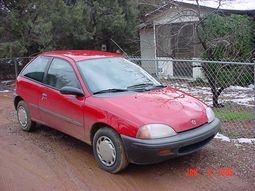
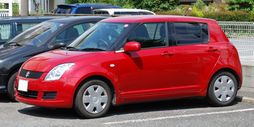
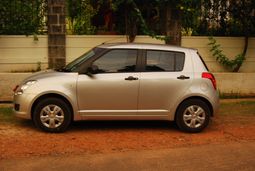
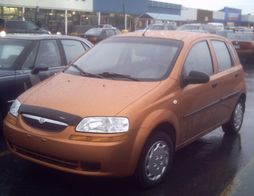
|